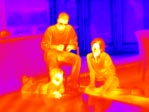Introduction to Radiant Floor Heating Systems
What is Radiant Floor Heating and why do people want it? Contractors and Home Owners need to know this information.
Radiant Floor Heating is a process by which energy leaves the surface of an object and travels to the surface of another (cooler) object in the form of electromagnetic waves.
In some cases this radiation can be seen. Sunlight, for example, delivers a portion of its energy to the earth as visible light.
In other cases the radiation is invisible. Radiant energy, having wavelengths longer than our eyes can see, is called infrared radiation or thermal radiation. This is the type of radiant energy most radiant panels emit.
All electromagnetic radiation, whether visible or invisible, shares several characteristics:
All radiation travels from warmer surfaces that emit it, to cooler surfaces that absorb it. Heat always moves from warmer to cooler materials regardless of what mode of heat transfer carries it.
Radiation only becomes heat when absorbed by a material.
 Sunlight travels through 93 Million miles of empty and frigid space, becoming heat only when absorbed by materials such as gas molecules in the atmosphere or the surface of a driveway. The instant it is absorbed it ceases to exist as electromagnetic radiation. The energy it contained passes to the absorbing material in the form of heat.
Sunlight travels through 93 Million miles of empty and frigid space, becoming heat only when absorbed by materials such as gas molecules in the atmosphere or the surface of a driveway. The instant it is absorbed it ceases to exist as electromagnetic radiation. The energy it contained passes to the absorbing material in the form of heat.Any surface can emit radiation to any other cooler surface within sight of it. The rate of radiant energy transfer depends on several factors, including:
The difference in temperature between the surfaces
The distance between the surfaces
The angle between the two surfaces
The optical properties of the surfaces (emissivity and absorptivity)
Radiant heat travels equally well in any direction. Most people think that heat rises. They're actually describing the fact that warm air rises because of its lower density. The fact that radiation travels downward just as effectively as upward is what enables a heated ceiling to effectively deliver heat to objects in the room below.
Air absorbs very little thermal radiation.
 This is an extremely important (and beneficial) characteristic of radiant floor heating. It's what allows radiant panel heating systems to directly warm objects without first heating the air around them. It explains why a person can feel the warmth of a campfire even though the air between them and the fire is cold. The radiant heat energy emitted by the flames only becomes "sensed" as heat when it arrives at and is absorbed by skin and clothing.
This is an extremely important (and beneficial) characteristic of radiant floor heating. It's what allows radiant panel heating systems to directly warm objects without first heating the air around them. It explains why a person can feel the warmth of a campfire even though the air between them and the fire is cold. The radiant heat energy emitted by the flames only becomes "sensed" as heat when it arrives at and is absorbed by skin and clothing.Thermal radiation can be partially reflected by certain surfaces. Some surfaces, such as polished metal, can reflect part of the infrared radiation that strikes them just like a mirror reflects visible light. Reflective insulation with one or more bright metallic foil surfaces is designed for just such a purpose. Most common interior building surfaces, however, have low reflective characteristics and therefore absorb most of the infrared radiation that strikes them.
Objects with surface temperatures below approximately 970F give off infrared radiation that's invisible to humans. All the radiant panel heating systems described in this training program fall into the infrared category. However, just because radiation emitted from low-temperature radiant panels is invisible doesn't mean it's any less capable of keeping us comfortable. Quite the contrary; in many cases the steady comfort delivered by a low temperature radiant panel is actually more comfortable than bursts of high intensity heat from a high temperature radiant panel. That being said, it's certainly possible to create a radiant heating panel that gives off a visible glow as it operates. A metal plate heated well above 1000 of in a blacksmith' s furnace is an example. The radiant energy given off by even a small object at such high temperatures can be felt several feet away.
All electromagnetic radiation travels at the speed of light. Regardless of whether it's thermal radiation or visible light, electromagnetic radiation travels away from the surface emitting it at approximately 186,000 miles per second. In the context of sending radiation across even large rooms, this is essentially instantaneous.
Thermal radiation is entirely different from nuclear radiation. Radiant heating systems do not emit subatomic particles or in any way create the health hazards often associated with emissions of nuclear radiation. While most people know this, remember that the word radiation doesn't often bring pleasant thoughts to mind for many consumers. It's important to draw the distinction.
Thermal radiation is not responsible for all the heat released by a "radiant" panel. Convection (and in some cases conduction) also plays a role. A typical "radiant" floor system gives off 50% to 70% of its heat as thermal radiation. The remainder is mostly released by gentle convective air currents. The heat output from a typical radiant ceiling however can be as much as 95% radiant. Because warm air against a heated ceiling doesn't "want" to circulate down into a room, convective transfer is very limited.